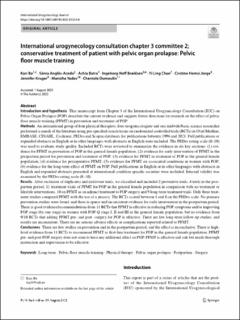| dc.contributor.author | Bø, Kari | |
| dc.contributor.author | Anglès-Acedo, Sònia | |
| dc.contributor.author | Batra, Achla | |
| dc.contributor.author | Brækken, Ingeborg Hoff | |
| dc.contributor.author | Chan, Yi Ling | |
| dc.contributor.author | Jorge, Cristine Homsi | |
| dc.contributor.author | Kruger, Jennifer | |
| dc.contributor.author | Yadav, Manisha | |
| dc.contributor.author | Dumoulin, Chantale | |
| dc.date.accessioned | 2022-09-14T07:51:54Z | |
| dc.date.available | 2022-09-14T07:51:54Z | |
| dc.date.created | 2022-08-29T11:17:32Z | |
| dc.date.issued | 2022 | |
| dc.identifier.citation | International Urogynecology Journal. 2022, Artikkel 05324-0. | en_US |
| dc.identifier.issn | 0937-3462 | |
| dc.identifier.uri | https://hdl.handle.net/11250/3017707 | |
| dc.description | This article is licensed under a Creative Commons Attribution 4.0 International License, which permits use, sharing, adaptation, distribution and reproduction in any medium or format, as long as you give appropriate credit to the original author(s) and the source, provide a link to the Creative Commons license, and indicate if changes were made. The images or other third party material in this article are included in the article's Creative Commons license, unless indicated otherwise in a credit line to the material. If material is not included in the article's Creative Commons license and your intended use is not permitted by statutory regulation or exceeds the permitted use, you will need to obtain permission directly from the copyright holder. | en_US |
| dc.description.abstract | Introduction and hypothesis: This manuscript from Chapter 3 of the International Urogynecology Consultation (IUC) on Pelvic Organ Prolapse (POP) describes the current evidence and suggests future directions for research on the effect of pelvic floor muscle training (PFMT) in prevention and treatment of POP.
Methods: An international group of four physical therapists, four urogynecologists and one midwife/basic science researcher performed a search of the literature using pre-specified search terms on randomized controlled trials (RCTs) in Ovid Medline, EMBASE, CINAHL, Cochrane, PEDro and Scopus databases for publications between 1996 and 2021. Full publications or expanded abstracts in English or in other languages with abstracts in English were included. The PEDro rating scale (0–10) was used to evaluate study quality. Included RCTs were reviewed to summarize the evidence in six key sections: (1) evidence for PFMT in prevention of POP in the general female population; (2) evidence for early intervention of PFMT in the peripartum period for prevention and treatment of POP; (3) evidence for PFMT in treatment of POP in the general female population; (4) evidence for perioperative PFMT; (5) evidence for PFMT on associated conditions in women with POP; (6) evidence for the long-term effect of PFMT on POP. Full publications in English or in other languages with abstracts in English and expanded abstracts presented at international condition specific societies were included. Internal validity was examined by the PEDro rating scale (0–10).
Results: After exclusion of duplicates and irrelevant trials, we classified and included 2 preventive trials, 4 trials in the post-partum period, 11 treatment trials of PFMT for POP in the general female population in comparison with no treatment or lifestyle interventions, 10 on PFMT as an adjunct treatment to POP surgery and 9 long-term treatment trials. Only three treatment studies compared PFMT with the use of a pessary. The RCTs scored between 4 and 8 on the PEDro scale. No primary prevention studies were found, and there is sparse and inconsistent evidence for early intervention in the postpartum period. There is good evidence/recommendations from 11 RCTs that PFMT is effective in reducing POP symptoms and/or improving POP stage (by one stage) in women with POP-Q stage I, II and III in the general female population, but no evidence from 9/10 RCTs that adding PFMT pre- and post -surgery for POP is effective. There are few long-term follow-up studies, and results are inconsistent. There are no serious adverse effects or complications reported related to PFMT.
Conclusions: There are few studies on prevention and in the postpartum period, and the effect is inconclusive. There is high-level evidence from 11 RCTs to recommend PFMT as first-line treatment for POP in the general female population. PFMT pre- and post-POP surgery does not seem to have any additional effect on POP. PFMT is effective and safe but needs thorough instruction and supervision to be effective. | en_US |
| dc.language.iso | eng | en_US |
| dc.subject | long-term | en_US |
| dc.subject | pelvic floor muscle training | en_US |
| dc.subject | pelvic organ prolapse | en_US |
| dc.subject | physical therapy | en_US |
| dc.subject | postpartum | en_US |
| dc.subject | surgery | en_US |
| dc.title | International urogynecology consultation chapter 3 committee 2; conservative treatment of patient with pelvic organ prolapse: Pelvic floor muscle training | en_US |
| dc.type | Peer reviewed | en_US |
| dc.type | Journal article | en_US |
| dc.description.version | publishedVersion | en_US |
| dc.rights.holder | © The Author(s) 2022 | en_US |
| dc.source.pagenumber | 35 | en_US |
| dc.source.journal | International Urogynecology Journal | en_US |
| dc.identifier.doi | 10.1007/s00192-022-05324-0 | |
| dc.identifier.cristin | 2046628 | |
| dc.description.localcode | Institutt for idrettsmedisinske fag / Department of Sports Medicine | en_US |
| dc.source.articlenumber | 05324-0 | en_US |
| cristin.ispublished | true | |
| cristin.fulltext | original | |
| cristin.qualitycode | 1 | |
